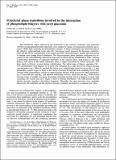Por favor, use este identificador para citar o enlazar a este item:
http://hdl.handle.net/10261/29152COMPARTIR / EXPORTAR:
 SHARE SHARE
 CORE
BASE CORE
BASE
|
|
| Visualizar otros formatos: MARC | Dublin Core | RDF | ORE | MODS | METS | DIDL | DATACITE | |

| Título: | Structural phase transitions involved in the interaction of phospholipid bilayers with octyl glucoside |
Autor: | Maza, Alfons de la CSIC; Parra Juez, José Luis CSIC | Fecha de publicación: | 15-dic-1994 | Citación: | European Journal of Biochemistry 226(3): 1029-38 (1994) | Resumen: | The transitional stages induced by the interaction of the nonionic surfactant octyl glucoside (OcOse) on phosphatidylcholine liposomes were studied by means of transmission electron microscopy (TEM), light scattering and permeability changes. A linear correlation was observed between the effective surfactant/lipid molar ratio (Re; three-stage model proposed for liposome solubilization) and the OcOse concentration in the initial and final interaction stages, despite showing almost a constant value during bilayer saturation. The bilayer/aqueous phase partition coefficient (K) decreased in the subsolubilizing interaction steps and increased during solubilization. Thus, whereas a preferential distribution of surfactant monomers in the aqueous phase with respect to the lipid bilayers took place in the initial interaction steps, a larger association of OcOse molecules with these lipids in bilayers occurred during solubilization. The initial steps of bilayer saturation (50-70% permeability) were attained for a lower free surfactant (Sw) than that for its critical micellar concentration (cmc). When Sw reached the OcOse cmc, solubilization started to occur (Resat). Large unilamellar vesicles began to form as the OcOse exceeded 60 mol/100 mol, exhibiting for 65 mol/100 mol (50% permeability) vesicles of approximately 400 nm. TEM pictures for 100% permeability (72 mol/100 mol) and Resat still showed unilamellar vesicles, albeit that the Resat TEM picture showing traces of smaller structures. Exceeding surfactant amounts led to a decrease in static light scattering; the vesicle-size curve began to show a bimodal distribution. The TEM picture showed tubular structures together with bilayer fragments. Thereafter, the open structures were gradually affected by the surfactant and the scattered intensity gradually decreased to a constant low value. | Descripción: | 6 pages, 2 figures.-- PMID: 7813457 [PubMed].-- Available online Mar 3, 2005. | Versión del editor: | http://dx.doi.org/10.1111/j.1432-1033.1994.t01-1-01029.x | URI: | http://hdl.handle.net/10261/29152 | DOI: | 10.1111/j.1432-1033.1994.t01-1-01029.x | ISSN: | 0014-2956 | E-ISSN: | 1432-1033 |
| Aparece en las colecciones: | (IQAC) Artículos |
Ficheros en este ítem:
| Fichero | Descripción | Tamaño | Formato | |
|---|---|---|---|---|
| Maza_Alfons_et_al.pdf | 1,17 MB | Adobe PDF |  Visualizar/Abrir |
CORE Recommender
SCOPUSTM
Citations
50
checked on 25-mar-2024
Page view(s)
316
checked on 18-abr-2024
Download(s)
333
checked on 18-abr-2024
Google ScholarTM
Check
Altmetric
Altmetric
NOTA: Los ítems de Digital.CSIC están protegidos por copyright, con todos los derechos reservados, a menos que se indique lo contrario.
